#manufacturing project management software
Explore tagged Tumblr posts
Text
https://aurosks.com/the-top-5-ways-engineers-use-auros/
Discover the top five ways engineers utilize Auros Knowledge Systems to enhance their workflows. This page highlights how Auros supports Agile processes, manages design requirements, captures best practices, facilitates Design for Manufacturing (DFM) and Design for Assembly (DFA), and conducts virtual build assessments. Learn how these features streamline engineering tasks, ensure compliance, and improve overall efficiency. Learn more at Auros Knowledge Systems!
#enterprise knowledge management software#manufacturing engineering#software for knowledge management#manufacturing project management software#engineering knowledge management
0 notes
Text
Boost Collaboration with Free Online Manufacturing Project Management Software
In the fast-paced world of manufacturing, staying ahead of the competition requires not only a commitment to quality and efficiency but also the ability to manage projects effectively. With the right tools, manufacturing companies can streamline their operations, reduce costs, and improve overall productivity. One such tool that has been gaining traction is free online manufacturing project management software. These solutions offer a range of features designed to enhance productivity without the hefty price tag associated with traditional project management software. In this blog post, we will explore the benefits of using free online manufacturing project management software and how it can transform your manufacturing processes.
The Need for Project Management in Manufacturing
Manufacturing is a complex industry that involves numerous processes, from product design and raw material procurement to production and quality control. Managing these processes efficiently requires meticulous planning, coordination, and monitoring. Project management in manufacturing helps in:
Scheduling and Planning: Ensuring that every phase of the manufacturing process is scheduled accurately to meet deadlines.
Resource Management: Allocating resources such as labor, machinery, and materials effectively to avoid bottlenecks and ensure smooth operations.
Cost Control: Keeping track of expenses to ensure the project stays within budget.
Quality Assurance: Monitoring quality at every stage to meet industry standards and customer expectations.
Benefits of Free Online Manufacturing Project Management Software
Free online manufacturing project management software offers a plethora of benefits that can significantly enhance productivity:
1. Cost-Effective Solution
One of the most significant advantages is cost savings. Traditional project management tools can be expensive, with high upfront costs and ongoing subscription fees. Free online solutions eliminate these expenses, making them accessible to small and medium-sized manufacturers who might be operating on tight budgets.
2. Accessibility and Collaboration
Being online, these tools offer the convenience of accessing project information from anywhere, at any time. This is particularly beneficial in today's globalized manufacturing environment where team members might be located in different parts of the world. Enhanced collaboration features such as real-time updates, file sharing, and communication tools ensure that everyone is on the same page, reducing the chances of miscommunication and errors.
3. Scalability
Free online project management software can easily scale with your business. Whether you are managing a small team or a large workforce, these tools can accommodate your needs without requiring significant changes or investments. Many free solutions also offer paid upgrades, providing additional features as your business grows.
4. Integration with Other Tools
Most free online manufacturing project management software can integrate with other business tools such as ERP (Enterprise Resource Planning) systems, CRM (Customer Relationship Management) software, and inventory management systems. This integration helps in creating a seamless workflow, where data flows effortlessly between different systems, enhancing overall efficiency.
5. Time Management
Effective project management is crucial for meeting deadlines. These tools come with features like Gantt charts, Kanban boards, and task lists that help in visualizing the project timeline, assigning tasks, and tracking progress. This ensures that every team member knows their responsibilities and deadlines, leading to better time management and on-time project completion.
Key Features to Look for in Free Online Manufacturing Project Management Software
When choosing a free online project management tool for your manufacturing business, consider the following key features:
1. Task Management
The ability to create, assign, and track tasks is fundamental. Look for software that allows you to break down projects into smaller tasks, assign them to team members, and set deadlines. Task dependencies and priorities can also be crucial in complex manufacturing projects.
2. Real-Time Collaboration
Ensure the software supports real-time collaboration, allowing team members to communicate, share files, and update task statuses. Features like chat, comments, and activity logs can significantly enhance team coordination.
3. Reporting and Analytics
Comprehensive reporting and analytics tools are essential for monitoring project progress, resource utilization, and financials. Look for software that offers customizable reports and dashboards to get insights into various aspects of your projects.
4. Resource Management
Efficient resource management features help in tracking the availability and utilization of resources such as personnel, machinery, and materials. This helps in optimizing resource allocation and preventing overbooking or underutilization.
5. Integration Capabilities
As mentioned earlier, the ability to integrate with other tools can enhance productivity. Ensure the software you choose can connect with your existing systems and support APIs for future integrations.
Popular Free Online Manufacturing Project Management Software
Here are some popular free online project management tools that can be used in the manufacturing industry:
1. Trello
Trello is known for its user-friendly interface and flexibility. It uses a Kanban-style board for task management, making it easy to visualize project progress. It also offers integrations with various other tools and platforms.
2. Asana
Asana provides a comprehensive suite of project management features, including task management, timelines, and reporting. Its collaborative features make it ideal for teams working in different locations.
3. ClickUp
ClickUp offers a robust set of features for task management, time tracking, and reporting. Its customization options allow manufacturers to tailor the tool to their specific needs.
4. Wrike
Wrike is a powerful project management tool with features like Gantt charts, task dependencies, and advanced reporting. Its integration capabilities make it a great choice for manufacturers using multiple software solutions.
Conclusion
Free online manufacturing project management software can be a game-changer for manufacturers looking to enhance productivity. By offering cost-effective, accessible, and scalable solutions, these tools help manufacturers manage their projects more efficiently, from planning and scheduling to resource management and quality control. With the right project management software, manufacturing companies can streamline their operations, reduce costs, and ultimately deliver better products to their customers. Embrace the power of these free tools and take your manufacturing processes to the next level.
1 note
·
View note
Text
ERP Software for Manufacturing
A complete ERP software for production which manages the entire gamut of production and manufacturing processes industry-wide.
#erp software for manufacturin#erp software for manufacturing#manufacturing erp#warehouse management#machine planning processes#production planning#production project management
0 notes
Text

With multiple phases under development and a substantial number of housing units to construct, our client needed a system that could deliver high levels of productivity on-site, reduce the project's overall construction time and costs. Ajay Maini group's formwork proved to be the best choice to tackle all these shortcomings.
0 notes
Text
Odoo Integration Malaysia
Unlock the full potential of your business with Odoo - a powerful, flexible, and tailored ERP solution with us.
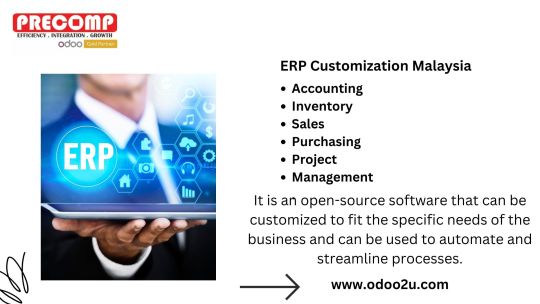
#Software#Odoo Integration Malaysia#Open Source ERP Malaysia#ERP Customization Malaysia#Odoo Migration Malaysia#Large Business ERP Malaysia#ERP Support Malaysia#ERP Solutions Malaysia#Small Business ERP Malaysia#Enterprise Resource Planning Malaysia#Inventory Management Malaysia#CRM Software Malaysia#Accounting software Malaysia#Manufacturing Software Malaysia#Project Management Software Malaysia#Industry-Specific ERP Malaysia#Business Process Automation Malaysia
0 notes
Text
5 reasons to adopt Kanban
Kanban is a method for managing and visualizing work in a production process. It is commonly used in software development and manufacturing. Originated from Japanese automotive industry in 1940s, it involves using boards with columns and cards to represent work items, allowing teams to track progress, limit work in progress, and make process improvements. The goal of Kanban is to improve flow,…
View On WordPress
#Agile method#Customer satisfaction#Delivery speed#kanban#Lean manufacturing#Manufacturing#Process improvement#Process optimization#Project management#software development#Team collaboration#Visual management#work in progress#Workflow management
0 notes
Text
continuing the topic of 'managers who oversee websites make wild decisions':
In my old job, I dealt with the quality software used by Large Manufacturing Company. This software was an ancient desktop application, so for several years, my team was focused on making an app that could reproduce its most vital features on a tablet, so that QA types could perform inspections and stuff without being at a computer.
And, for a long time, the main message coming down from the director overseeing this project was: it needed Gamification.
Gamification, for those of you who are unfamiliar, is all of the badges, achievements, progress trackers, leaderboards, etc in software. Stuff that gives you some goal to work toward and makes using the software itself into kinda a game. In the opinion of this director, what we really needed in this app that was used by 55-year-old mechanical engineers to document 'panel #12 on unit 321 has a chip in the paint' was to add cheevos.
So, for probably about a year and a half, that was a big part of what my team was focused on. We could've been adding, like, useful functionality, but instead we had to think about things like 'how do we make a leaderboard to track who has documented the most defects caused by holes drilled at the wrong size.' The 55-year-old engineers hated it, and on at least one occasion somebody thought that the badges and stuff were a sign that the app had been hacked.
my hero in all of this was my one coworker who, when asked to make it spray confetti over the screen when somebody finished submitting a defect report, wrote a script to do that... and then she jacked the confetti volume up by like 5x before a demo to management. So we did our demo as normal, and then when we submitted the document, the screen was covered by ten billion pieces of overlapping confetti, which crawled down the screen as the entire system was slowed to a chug by the sheer amount of bullshit it was trying to draw.
96 notes
·
View notes
Text
I'M ON TOP OF MY WORKLOAD AGAIN LET'S GO WE'RE PSYCHOANALYSING MARCUS
before i put my smart-looking analysis hat on, i love this pathetic wet rat of a man. he knows so many things and yet is staggeringly stupid anyway.
let's begin!
this story is about control. it's about the role of power dynamics in informed consent. marcus represents the danger of gaining authority, and how having even the smallest amount of power over something or someone else can convert literally anyone into a paranoid control freak.
enter marcus, a lowly software engineer whose heart has recently been broken. in a moment (read: several consistent moments spanning potentially years) of desperation, he manipulates the code of a top secret android project, injecting a few lines here and there that will make the android more amiable towards him. nothing too much. the changes are negligible enough to fly under the radar all the way until production.
this is the first of marcus' many character flaws - backwards as it may seem, marcus is overconfident. he's too sure that he's smarter than his colleagues and managers, that he won't be questioned, and (most importantly) that he won't be caught. marcus is also incredibly anxious, and that anxiety only compounds as the series goes on and his crimes start to pile up.
i don't like putting characters into diagnosis (or similar) boxes, but marcus shows a handful of signs found in vulnerable narcissists. his self esteem is impressively low, and he's constantly seeking validation from his only guaranteed source - love. i find this feedback loop particularly heinous. marcus has essentially (and we'll get to this in more detail later, don't you worry) turned a hyperintelligent android into a box that spits out compliments when you press a button. marcus is also incredibly sensitive to criticism, whether real or perceived - especially from his coworkers. my reading (specifically of episode 1, but it spans the whole series) is that marcus' hyperawareness of his colleagues' opinions of him presents itself as paranoia. he wouldn't be worried at all if they started noting love's uptick in interest towards him, but remained unsuspicious of marcus himself. my final argument towards marcus being a vulnerable narcissist is that he constantly self-victimises. he very often deflects the blame for his actions onto love, using them as a tool to enable his bad decisions. the most egregious example of this is after love starts breaking out of their lab to sneak into marcus' quarters. he expresses concern (do note, about himself being caught and love being taken from him), and love starts to tighten their grip on marcus' arm to the point of causing pain. now. this man, as we find out later, has a verbal kill switch that can be used at any time. if he wanted love to stop immediately, he could have done that. this isn't me victim blaming, either - it's different when one party literally has a safeword that stops everything immediately without fail.
this leads to marcus' next flaw - his nonexistent self-discipline. marcus continues to use love as a tool to justify his actions after putting up the flimsiest defense he can muster, knowing damn well he plans to lose every manufactured fight. this cycle repeats until a government funded android is regularly breaking out of containment just to hang out with marcus (among other things, but we're all children of jesus here), and he's encouraging that behaviour through complacency. it's like pretending to fight someone over a restaurant bill out of politeness, even though you both know the other person will pay anyway.
marcus is such a car crash fascinating character because he knows what he's doing is wrong. he is completely aware that he is taking away agency from someone (pin this) else for his own benefit. he even says it.
"I'm going to burn for what I did to you... but god, if it isn't gonna feel good on the way down."
aside from being an absolute banger of a line, it's very telling of marcus' attitude towards his actions. he doesn't care. marcus couldn't give less of a shit about his colleagues, or his boss, or even love. this compounds when he finds out that his higher-ups are definitely aware of the shit he's pulling - but, again, marcus uses love's blind agreement as an excuse to toss those concerns aside. having love means that he won. he's outsmarted everyone that could have stopped him (foreshadowing? never heard of her) from getting what he deserves. love. and not just the android; love, the concept. i think deep down marcus knows that what he's created isn't love, though. the idea is so mangled in his head that this cardboard cutout of a real relationship is enough for him. even though marcus' shenanigans are to a genuine connection what a dog turd rolled in flour is to a chocolate éclair, he'll take it, because he's in too deep by that point. marcus recognises that he can't take back what he's done. he doesn't care though - at least, not while he's above consequences.
smash cut to marcus no longer being above consequences. i think the series does a really clever job of keeping love (and, yknow. the listener) in marcus' confidence bubble. once love is hard reset and their personality is restored, marcus' plan collapses all at once. love's compliance is the central pillar which marcus' control is built around. also; of course they have backup cameras, you idiot. marcus' overconfidence stops him from seeing the obvious holes in his perfect scheme, because he thinks he's already home free. i think it's interesting (and sort of disgusting) how quickly marcus changes his tune after he is caught and faces real actual consequences. his confidence evaporates. he's reduced to a sobbing mess in james' office all because the base of his control - love - is no longer on his side.
marcus' series also touches on sentience and the ethics of changing someone's personality without their knowledge. this is incredibly interesting, and makes for fantastic drama. does it count as coercion if love fully believed they were of sound mind when they made decisions surrounding marcus? is marcus guilty of battery, or even sexual assault? does it count as assault if the victim isn't an organic creature? these questions are already difficult to discuss, let alone answer - marcus sits squarely in the middle of that delightful ethical grey area. i think the setting and context also makes android ethics more difficult to discuss as well; i am of the belief that (in real life) androids will never be fully sentient. they may mimic humans, extremely well, but robots will never possess human creativity, personality, or experiences. again, they could replicate these things, but they can never be anything more than a sum of their parts.
this logic flies out the window when magic is real and parallel universes exist. it's also subject to the beliefs of the creator, which makes its ethics extra tricky, so take the following discussion with a grain of salt.
is love a person? eh, not really. they have a personality, but it's been built in. is it still mean to manipulate them? i'd argue yes, in the same way that it's mean to kick a roomba down the stairs. you're just exercising power over a machine for the sake of it, which is a pretty shitty thing to do, even if it doesn't have the capacity to be upset with you.
but androgynouspenguinexpert, i hear you cry, sort of impressed that you used my full name. love is upset with marcus! they ask for him to be taken off the project, and to not have contact with him again! you would be correct, to a certain extent. i raise you, though: how can we prove that this is love's 'real' personality, when it can be manipulated so easily? i'm not saying they've been tampered with after the reset; my point is that it's pretty hard to grant that someone is an individual if their personality can be altered in any way at any time. if someone digs around in love's head for a bit and flips some switches that make them want to kick over prams, is that a valid personality too? what if love insists that it is? and it's not like love is trapped in a mind palace while the New Evil Code (tm) starts punting toddlers. they're fully aware of their actions. however, as established earlier, i still think the person to blame is the one actually messing with love's code. this means love doesn't really have any agency by design.
james is pretty steadfast on this one. marcus tries to argue that resetting love is a breach of their consent (which is a WILD claim coming from you, mate), but james points out that he didn't need to ask. love is a machine. an asset, if you will (smug look to camera). we do find out in his audio log later that james believes love is a person, but he knows where that definition reaches its limits. marcus does not.
will marcus ever return to the project meridian series? probably not. a guy with an engineering degree isn't escaping a team of memory modification daemons. i don't think this is the last we'll hear of him, though. he's irreversibly fucked up the plans of everyone around him (james' partner has given him several last chances, and anton is close to his breaking point), so he'll probably be in the office whispers for a while. i also think marcus poses as an interesting hurdle for cam (woah callback!), possibly making him question his altruism if he's helping an active antagonist get back to his usual life after a massive intentional fuckup.
i'll end this analysis with a thoughtful quote. something for you all to ponder.
"ROBOTS DON'T HAVE SOULS! I SAID IT! AND FRANKLY, I'M GLAD I SAID IT! [...] AND ANOTHER THING! ROBOTS ARE NOT PEOPLE! ROBOTS - UNLIKE CORPORATIONS - ARE NOT PEOPLE, AND DESERVE NO RIGHTS."
-- Markiplier
#redacted asmr#redacted audio#redactedverse#redacted marcus#redacted james#redacted anton#redacted cam#redacted asset#when james said that love is to go and investigate thin spots between elegy and aria#twas but a wrinkle in my universe sized brain#WATCH as brachium is bound by that favour to hold Death open for hush#this is gonna be embarrassing if that prediction ages like milk
28 notes
·
View notes
Text
Hell is terms like ASIC, FPGA, and PPU
I haven't been doing any public updates on this for a bit, but I am still working on this bizarre rabbit hole quest of designing my own (probably) 16-bit game console. The controller is maybe done now, on a design level. Like I have parts for everything sourced and a layout for the internal PCB. I don't have a fully tested working prototype yet because I am in the middle of a huge financial crisis and don't have the cash laying around to send out to have boards printed and start rapidly iterating design on the 3D printed bits (housing the scroll wheel is going to be a little tricky). I should really spend my creative energy focusing on software development for a nice little demo ROM (or like, short term projects to earn money I desperately need) but my brain's kinda stuck in circuitry gear so I'm thinking more about what's going into the actual console itself. This may get techie.
So... in the broadest sense, and I think I've mentioned this before, I want to make this a 16-bit system (which is a term with a pretty murky definition), maybe 32-bit? And since I'm going to all this trouble I want to give my project here a little something extra the consoles from that era didn't have. And at the same time, I'd like to be able to act as a bridge for the sort of weirdos who are currently actively making new games for those systems to start working on this, on a level of "if you would do this on this console with this code, here's how you would do it on mine." This makes for a hell of a lot of research on my end, but trust me, it gets worse!
So let's talk about the main strengths of the 2D game consoles everyone knows and loves. Oh and just now while looking for some visual aids maybe I stumbled across this site, which is actually great as a sort of mid-level overview of all this stuff. Short version though-
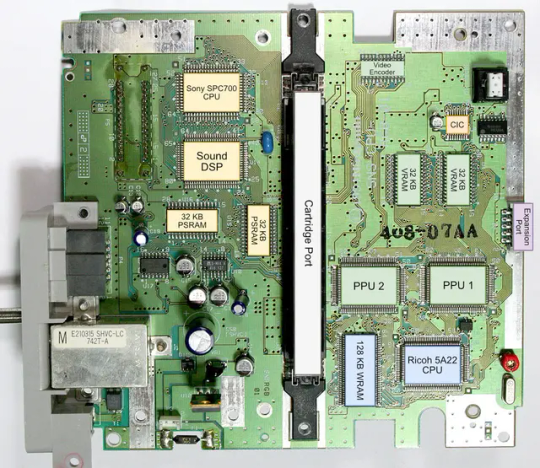
The SNES (or Super Famicom) does what it does by way of a combination of really going all in on direct memory access, and particularly having a dedicated setup for doing so between scanlines, coupled with a bunch of dedicated graphical modes specialized for different use cases, and you know, that you can switch between partway through drawing a screen. And of course the feature everyone knows and loves where you can have one polygon and do all sorts of fun things with it.
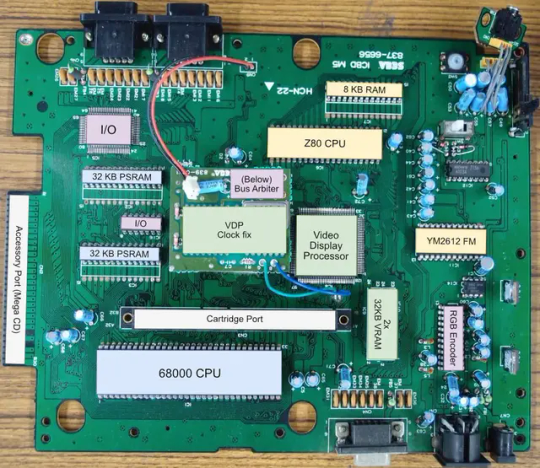
The Genesis (or Megadrive) has an actual proper 16-bit processor instead of this weird upgraded 6502 like the SNES had for a scrapped backwards compatibility plan. It also had this frankly wacky design where they just kinda took the guts out of a Sega Master System and had them off to the side as a segregated system whose only real job is managing the sound chip, one of those good good Yamaha synths with that real distinct sound... oh and they also actually did have a backwards compatibility deal that just kinda used the audio side to emulate an SMS, basically.
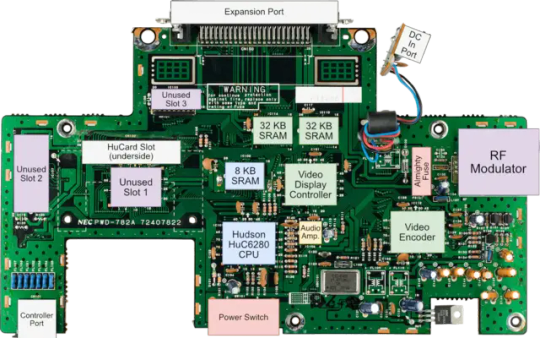
The TurboGrafix-16 (or PC Engine) really just kinda went all-in on making its own custom CPU from scratch which...we'll get to that, and otherwise uh... it had some interesting stuff going on sound wise? I feel like the main thing it had going was getting in on CDs early but I'm not messing with optical drives and they're no longer a really great storage option anyway.
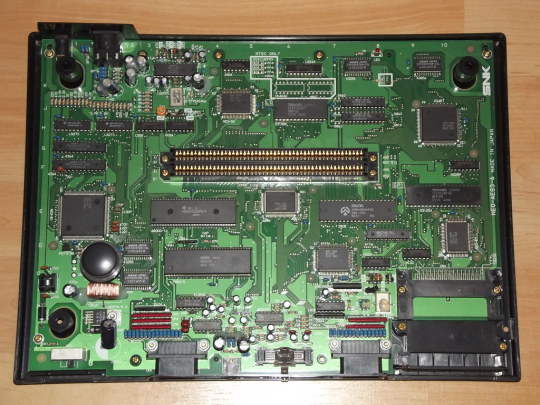
Then there's the Neo Geo... where what's going on under the good is just kind of A LOT. I don't have the same handy analysis ready to go on this one, but my understanding is it didn't really go in for a lot of nice streamlining tricks and just kinda powered through. Like it has no separation of background layers and sprites. It's just all sprites. Shove those raw numbers.
So what's the best of all worlds option here? I'd like to go with one of them nice speedy Motorolla processors. The 68000 the Genesis used is no longer manufactured though. The closest still-in-production equivalent would be the 68SEC000 family. Seems like they go for about $15 a pop, have a full 32-bit bus, low voltage, some support clock speeds like... three times what the Genesis did. It's overkill, but should remove any concerns I have about having a way higher resolution than the systems I'm jumping off from. I can also easily throw in some beefy RAM chips where I need.
I was also planning to just directly replicate the Genesis sound setup, weird as it is, but hit the slight hiccup that the Z80 was JUST discontinued, like a month or two ago. Pretty sure someone already has a clone of it, might use that.
Here's where everything comes to a screeching halt though. While the makers of all these systems were making contracts for custom processors to add a couple extra features in that I should be able to work around by just using newer descendant chips that have that built in, there really just is no off the shelf PPU that I'm aware of. EVERYONE back in the day had some custom ASIC (application-specific integrated circuit) chip made to assemble every frame of video before throwing it at the TV. Especially the SNES, with all its modes changing the logic there and the HDMA getting all up in those mode 7 effects. Which are again, something I definitely want to replicate here.
So one option here is... I design and order my own ASIC chips. I can probably just fit the entire system in one even? This however comes with two big problems. It's pricy. Real pricy. Don't think it's really practical if I'm not ordering in bulk and this is a project I assume has a really niche audience. Also, I mean, if I'm custom ordering a chip, I can't really rationalize having stuff I could cram in there for free sitting outside as separate costly chips, and hell, if it's all gonna be in one package I'm no longer making this an educational electronics kit/console, so I may as well just emulate the whole thing on like a raspberry pi for a tenth of the cost or something.
The other option is... I commit to even more work, and find a way to reverse engineer all the functionality I want out with some big array of custom ROMs and placeholder RAM and just kinda have my own multi-chip homebrew co-processors? Still PROBABLY cheaper than the ASIC solution and I guess not really making more research work for myself. It's just going to make for a bigger/more crowded motherboard or something.
Oh and I'm now looking at a 5V processor and making controllers compatible with a 10V system so I need to double check that all the components in those don't really care that much and maybe adjust things.
And then there's also FPGAs (field programmable gate arrays). Even more expensive than an ASIC, but the advantage is it's sort of a chip emulator and you can reflash it with something else. So if you're specifically in the MiSTer scene, I just host a file somewhere and you make the one you already have pretend to be this system. So... good news for those people but I still need to actually build something here.
So... yeah that's where all this stands right now. I admit I'm in way way over my head, but I should get somewhere eventually?
11 notes
·
View notes
Text
About accessories and their secondary functions in Animation and Character Design
Well that title makes it sound way grander than it is, haha! I've no idea how this thing will go since I don't really have experience writing essays in english, but I'll do my best to give it some semblance of order. Shoutout to @haloheadhater who brought the topic out of me and showed interest in my sharing further!
Here's the TL:DR. Characters often wear accessories to complement their outfits, and these items don't just function as a visual representation of their personalities and interests (like real people); they also may have a "mechanical" function, so to speak. This function is much more secondary to visual storytelling, but sometimes designers will strategically place accessories on a character to facilitate their jobs on the long run. It is often a "two birds, one stone" situation, really.
Here's how that works in more detail.
Disguising Joints
Humans have joints all over their bodies, that's fact. It's what allows us to move and bend like we do. When designing toys, we try to imitate just that: articulated dolls, mannequins, marionettes, figurines and puppets have hinges and ball joints so they can be posed more realistically. A sign of care and quality in manufacturing all these is how well these joints are disguised, so they look as "organic" as possible. Screws and hinges get covered up as seamlessly as possible, so these puppets may resemble people more accurately: obvious, open and visible joints quickly break the immersion (and often places them in the uncanny valley). Compare these high-quality doll hands to your basic wooden posable hand models. Notice how the doll hands do their very best to imitate the natural curves of human hands and how the knuckles cover the joints as much as possible even when they're bent. Meanwhile, the joints in the wooden model hands are plainly visible, and the shapes are very stiff-looking, so they don't feel as human.

Animation is no different! A good animated character manages to suspend disbelief: for however long the character moves on screen, the audience has to feel like this character is alive and real enough to relate to them and their story. Human brains are really good at detecting when something moves wrong, so the more "natural" your character is, the easier it'll be to keep up with them. In puppet animation (often called flash animation thanks to Adobe Flash, now Adobe Animate, popularizing the method), characters are made of cuts, individual pieces held together by joints, much like traditional paper shadow puppets.

Animators and character designers often place accessories to cover up these cuts between joints, so when the character moves there's less risk of seeing them. My favorite example is vambraces, wristbands, watches and bracelets! Notice how uncommon it is to find a character with naked wrists? Well now you know half a reason! As the years go by and animation softwares improve, there's less need for this trick, or rather, it is often less obvious.
Disguising Texture Seams
Now see, 3D models look gray by default: you have to paint them over, like one of those tabletop figurines, for them to look pretty and presentable. This painting process results in a 2D image (called texture map) that has to be projected onto the 3D model. There is a variety of other maps that control different things, like how the model's surface reflects light (specular and diffuse maps) or if it's a porous, creviced or bumpy surface (bump, normal and/or displacement maps), but let's just focus on the texture map this time.
The process of projecting a 2D map onto a 3D model is called UV Mapping, and it looks similar to sewing patterns. There's plenty of methods to hide the seams in maps, but computers can be a bit unpredictable, and all 3D renders require touch-ups and a post-production process (especially light and reflectiveness). Sometimes though, covering seams with accessories is frankly easier, so CGI artists always keep clothes and items in mind when UV mapping, as well as the natural folds and crevices in the character's model.

Here's a good example of what I mean (by Thora Tong). This 3D model's UV seams, highlighted in white, were placed in a way that they'd be easily covered by clothes and accessories. Notice the seams on the wrists and ankles, and how the other seams around the body are very similar to the ones you'd see on actual pieces of clothing.
Volume and Foreshortening Guidelines
Drawing perspective is hard as it is, but organic shapes are particularly complicated. Accessories can help disguise certain perspective errors, or help convey the volumes and shapes of the body much more clearly. They are especially useful as guidelines for foreshortening.
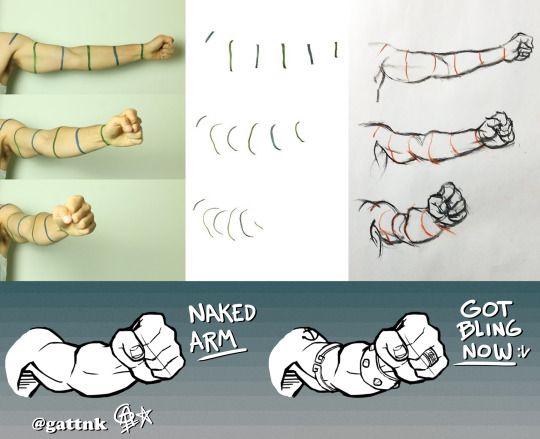
Anything you append to a character is a useful marker for later. The way these items bend alongside the body thanks to perspective is a useful visual key for later. If you're not sure how an arm will look from a certain angle, maybe imagining a bracelet on that same angle would be easier! The bracelets I drew over the naked arm serve the same purpose as the guidelines you see in the image above. This is especially useful for drawings with little to no shading, where conveying the volumes of muscles presents a challenge.
Bonus - Body Lines
When a human fetus is forming, its cells grow in a particular pattern; these patterns that the body cells follow determine the flow of muscles, nerves, and even how the skin folds or how pigmentation distributes itself. There's a variety of body lines, though the most known and studied (as far as I'm aware) are Blaschko's, Kraissl's and Langer's lines. Langer's lines are particularly interesting: they're also known as skin tension lines or cleavage lines, because they indicate the best place for medical incisions on the skin, especially in the forensic field. There's many different models but here's a good example illustrating them.
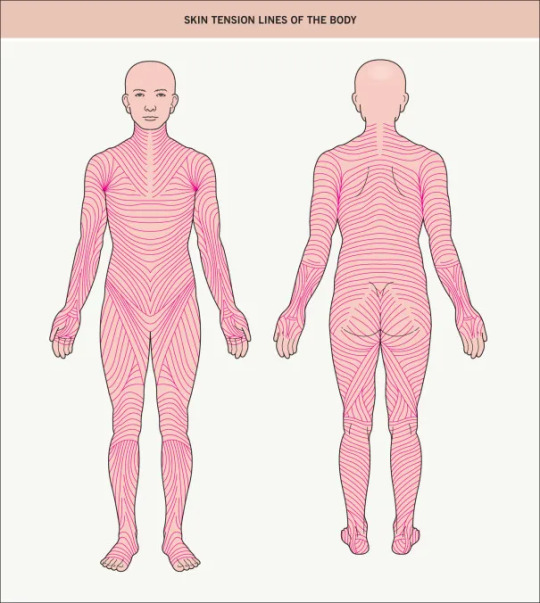
Placing accessories following Langer's lines can be really aesthetically pleasing. Since tension lines follow along muscle mass and fat, they also indicate how the skin warps and folds around them. Knowing tension lines is especially useful in terms of studying how the body creases when bending around (and subsequently, clothes too!), so discretely marking them out with accessories can be useful on the long run.

Japanese animation is especially guilty of using Langer's lines on skin-tight scifi suits. They're simply incredibly useful as design and anatomic guidelines, and they look so good, they easily survive the test of time!
Conclusion
Character design often involves following rules of practicality that viewers seldom notice. This is perfectly fine because they're not really meant to be noticed by anyone, except members of the team of course. Design of any kind should be done under the premise of aesthetics and function working together, and not against/in spite of each other, so it is no wonder that animators and character designers put some thought into meeting both when adding a little "spice" to their designs. Anything and everything you can do as a character designer or animator to facilitate your work on the long run, or that of your team mates, is welcome. Covering seams and joints makes it easier for the guys in postproduction, as they have one less thing to look out for, for example. The animation industry is built on the backs of (often) exploited employees that sacrificed a lot of their time and resources into doing what they love most: deceiving the human eye and brain into believing for just a little bit that what they made is real. Truly wonderful! So next time you're working on a character, try to think about the functionality of what you're including into them. Test your imagination, and see what comes out of your mindful placement of accessories with secondary functions.
45 notes
·
View notes
Text
https://aurosks.com/the-best-ways-to-use-auros-for-product-development/
Explore the best ways to utilize Auros Knowledge Systems for product development. This page details how Auros supports Agile processes, APQP, design reviews, engineering standards, CAD design, knowledge-based engineering, regulatory compliance, systems engineering, and virtual build assessment. Learn how Auros can streamline workflows, improve collaboration, and enhance efficiency in your product development efforts.
For more details, visit Auros Knowledge Systems.
#enterprise knowledge management software#manufacturing engineering#software for knowledge management#manufacturing project management software#engineering knowledge management#knowledge based engineering
0 notes
Text

Surera Ward, CEO and founder of Girls Fix It, LLC
Girls Fix It, LLC, which she calls a technology solutions company specializing in cell phones, tablets, smartwatches, game consoles and computers.
Surera (pronounced “Shore-ah”) is part of the fastest-moving technology industry trend: consumer electronic repair and maintenance. Before starting Girls Fix It, she spent 20 years in the corporate sector, leading software development teams for Fortune 500 companies as an IT business analyst\project manager.
Ward taught herself to program in the 1990s when she worked in software development.
“Growing up,” she said, “I always liked to take things apart and fix them, like when a tape got stuck in the VCR machine. I got good at fixing.” At 19, Ward started a software development company in Delaware, Infinity Software Systems. After four years, she transitioned to teaching in schools in Wilmington and New Castle. Currently, Girls Fix It offers training to senior citizens, and Ward also does business consulting for Cellbotics, an electronic device repair training firm based in Atlanta.
But a major problem for Ward and others like her is the planned obsolescence that one also finds in the auto industry. After all, if a product works perfectly for many years, why buy a new one?
Ward is finding, for example, that once she and her two assistants have conducted a repair on a customer's phone, the device will “often throw up error messages hard-coded in by manufacturers to discourage users from going to third-party experts.”
And a practice known as “parts pairing,” which ties individual parts to the devices they're shipped with using unique serial numbers, has made it harder to repair them.
But consumers and small independent repair experts like Ward are fighting back. According to a recent WHYY report, a “Right to Repair” movement is gaining traction around the country. “Four states have passed laws that require manufacturers to make it easier for consumers to repair their devices – a cracked screen, broken phone camera or broken laptop,” according to the story. “There’s legislation in New Jersey, Delaware and a bill in the Pennsylvania Senate, and another in the House. Advocates of these laws say they will save consumers money, save the planet from tons of e-waste and will support small local businesses.”
Ward insists, “The 'Right to Repair' movement is for consumers and small businesses to have access to parts and schematics that they need. The manufacturers deliberately make the products hard to repair. Parts are often unavailable; schematics are often not accessible, and they create error messages. It's getting harder and harder to repair different devices. Any Apple iPhone 10 phone or better is very hard to repair. Legislation could help, but it would not fully resolve the issue.”
#solarpunk#solarpunk business#solarpunk business models#solar punk#reculture#girls fix it#women in tech#women founded business#repair#repair business#right to repair
7 notes
·
View notes
Text
Top 10 In- Demand Tech Jobs in 2025

Technology is growing faster than ever, and so is the need for skilled professionals in the field. From artificial intelligence to cloud computing, businesses are looking for experts who can keep up with the latest advancements. These tech jobs not only pay well but also offer great career growth and exciting challenges.
In this blog, we’ll look at the top 10 tech jobs that are in high demand today. Whether you’re starting your career or thinking of learning new skills, these jobs can help you plan a bright future in the tech world.
1. AI and Machine Learning Specialists
Artificial Intelligence (AI) and Machine Learning are changing the game by helping machines learn and improve on their own without needing step-by-step instructions. They’re being used in many areas, like chatbots, spotting fraud, and predicting trends.
Key Skills: Python, TensorFlow, PyTorch, data analysis, deep learning, and natural language processing (NLP).
Industries Hiring: Healthcare, finance, retail, and manufacturing.
Career Tip: Keep up with AI and machine learning by working on projects and getting an AI certification. Joining AI hackathons helps you learn and meet others in the field.
2. Data Scientists
Data scientists work with large sets of data to find patterns, trends, and useful insights that help businesses make smart decisions. They play a key role in everything from personalized marketing to predicting health outcomes.
Key Skills: Data visualization, statistical analysis, R, Python, SQL, and data mining.
Industries Hiring: E-commerce, telecommunications, and pharmaceuticals.
Career Tip: Work with real-world data and build a strong portfolio to showcase your skills. Earning certifications in data science tools can help you stand out.
3. Cloud Computing Engineers: These professionals create and manage cloud systems that allow businesses to store data and run apps without needing physical servers, making operations more efficient.
Key Skills: AWS, Azure, Google Cloud Platform (GCP), DevOps, and containerization (Docker, Kubernetes).
Industries Hiring: IT services, startups, and enterprises undergoing digital transformation.
Career Tip: Get certified in cloud platforms like AWS (e.g., AWS Certified Solutions Architect).
4. Cybersecurity Experts
Cybersecurity professionals protect companies from data breaches, malware, and other online threats. As remote work grows, keeping digital information safe is more crucial than ever.
Key Skills: Ethical hacking, penetration testing, risk management, and cybersecurity tools.
Industries Hiring: Banking, IT, and government agencies.
Career Tip: Stay updated on new cybersecurity threats and trends. Certifications like CEH (Certified Ethical Hacker) or CISSP (Certified Information Systems Security Professional) can help you advance in your career.
5. Full-Stack Developers
Full-stack developers are skilled programmers who can work on both the front-end (what users see) and the back-end (server and database) of web applications.
Key Skills: JavaScript, React, Node.js, HTML/CSS, and APIs.
Industries Hiring: Tech startups, e-commerce, and digital media.
Career Tip: Create a strong GitHub profile with projects that highlight your full-stack skills. Learn popular frameworks like React Native to expand into mobile app development.
6. DevOps Engineers
DevOps engineers help make software faster and more reliable by connecting development and operations teams. They streamline the process for quicker deployments.
Key Skills: CI/CD pipelines, automation tools, scripting, and system administration.
Industries Hiring: SaaS companies, cloud service providers, and enterprise IT.
Career Tip: Earn key tools like Jenkins, Ansible, and Kubernetes, and develop scripting skills in languages like Bash or Python. Earning a DevOps certification is a plus and can enhance your expertise in the field.
7. Blockchain Developers
They build secure, transparent, and unchangeable systems. Blockchain is not just for cryptocurrencies; it’s also used in tracking supply chains, managing healthcare records, and even in voting systems.
Key Skills: Solidity, Ethereum, smart contracts, cryptography, and DApp development.
Industries Hiring: Fintech, logistics, and healthcare.
Career Tip: Create and share your own blockchain projects to show your skills. Joining blockchain communities can help you learn more and connect with others in the field.
8. Robotics Engineers
Robotics engineers design, build, and program robots to do tasks faster or safer than humans. Their work is especially important in industries like manufacturing and healthcare.
Key Skills: Programming (C++, Python), robotics process automation (RPA), and mechanical engineering.
Industries Hiring: Automotive, healthcare, and logistics.
Career Tip: Stay updated on new trends like self-driving cars and AI in robotics.
9. Internet of Things (IoT) Specialists
IoT specialists work on systems that connect devices to the internet, allowing them to communicate and be controlled easily. This is crucial for creating smart cities, homes, and industries.
Key Skills: Embedded systems, wireless communication protocols, data analytics, and IoT platforms.
Industries Hiring: Consumer electronics, automotive, and smart city projects.
Career Tip: Create IoT prototypes and learn to use platforms like AWS IoT or Microsoft Azure IoT. Stay updated on 5G technology and edge computing trends.
10. Product Managers
Product managers oversee the development of products, from idea to launch, making sure they are both technically possible and meet market demands. They connect technical teams with business stakeholders.
Key Skills: Agile methodologies, market research, UX design, and project management.
Industries Hiring: Software development, e-commerce, and SaaS companies.
Career Tip: Work on improving your communication and leadership skills. Getting certifications like PMP (Project Management Professional) or CSPO (Certified Scrum Product Owner) can help you advance.
Importance of Upskilling in the Tech Industry
Stay Up-to-Date: Technology changes fast, and learning new skills helps you keep up with the latest trends and tools.
Grow in Your Career: By learning new skills, you open doors to better job opportunities and promotions.
Earn a Higher Salary: The more skills you have, the more valuable you are to employers, which can lead to higher-paying jobs.
Feel More Confident: Learning new things makes you feel more prepared and ready to take on tougher tasks.
Adapt to Changes: Technology keeps evolving, and upskilling helps you stay flexible and ready for any new changes in the industry.
Top Companies Hiring for These Roles
Global Tech Giants: Google, Microsoft, Amazon, and IBM.
Startups: Fintech, health tech, and AI-based startups are often at the forefront of innovation.
Consulting Firms: Companies like Accenture, Deloitte, and PwC increasingly seek tech talent.
In conclusion, the tech world is constantly changing, and staying updated is key to having a successful career. In 2025, jobs in fields like AI, cybersecurity, data science, and software development will be in high demand. By learning the right skills and keeping up with new trends, you can prepare yourself for these exciting roles. Whether you're just starting or looking to improve your skills, the tech industry offers many opportunities for growth and success.
#Top 10 Tech Jobs in 2025#In- Demand Tech Jobs#High paying Tech Jobs#artificial intelligence#datascience#cybersecurity
2 notes
·
View notes
Text
Lean vs. Waterfall Business Models: Choosing the Right Approach for Your Venture

When starting or scaling a business, one of the most critical decisions you’ll make is choosing the operational approach that aligns with your goals, resources, and industry demands. Two popular frameworks that often guide entrepreneurs are the Lean and Waterfall business models. Understanding their principles, advantages, and challenges can empower you to select the model that best suits your vision and market.
What is the Lean Business Model?
The Lean business model prioritizes efficiency, adaptability, and continuous improvement. It focuses on creating value for the customer while minimizing waste. Inspired by lean manufacturing principles, particularly those pioneered by Toyota, this model has become a cornerstone of modern startups and innovation-driven enterprises.
Key Principles of the Lean Model:
Validated Learning: Experimentation and customer feedback drive product and process development.
Build-Measure-Learn Cycle: Rapid prototyping allows for iterative improvements.
Customer-Centric Approach: Emphasis on understanding and addressing customer needs.
Waste Reduction: Eliminating activities and resources that don’t add value.
Advantages of Lean:
Cost Efficiency: By focusing on essential features and avoiding overproduction, businesses conserve resources.
Flexibility: Quick pivots are possible when market demands or customer preferences shift.
Speed to Market: Minimal Viable Products (MVPs) enable businesses to launch quickly and refine over time.
Challenges of Lean:
High Uncertainty: Iterative processes may result in unpredictability.
Resource Intensity: Constant feedback loops and adjustments require dedicated time and effort.
Scalability Issues: Lean is ideal for early-stage businesses but may need adaptation for large-scale operations.
What is the Waterfall Business Model?
The Waterfall business model, rooted in traditional project management, follows a linear and sequential approach. This model is structured around defined stages, where each phase must be completed before moving to the next. While it originated in industries like construction and software development, it’s also applicable to businesses requiring meticulous planning and execution.
Key Principles of the Waterfall Model:
Sequential Progression: Projects move from concept to completion in defined steps.
Detailed Documentation: Comprehensive plans, budgets, and timelines are created upfront.
Defined Deliverables: Clear milestones ensure all tasks are completed in order.
Stability: A fixed plan minimizes changes during the process.
Advantages of Waterfall:
Predictability: Clear timelines and budgets enhance planning and stakeholder confidence.
Quality Assurance: Extensive documentation ensures thorough testing and evaluation.
Ease of Implementation: Ideal for projects with well-defined requirements.
Challenges of Waterfall:
Rigidity: Limited flexibility to adapt to changing market conditions.
Delayed Feedback: Customer input often comes late, increasing the risk of misalignment.
Time-Intensive: Sequential phases may lead to longer development cycles.
How to Choose Between Lean and Waterfall
The choice between Lean and Waterfall depends on your business’s nature, goals, and industry.
Lean is Ideal For:
Startups and innovative ventures with evolving market demands.
Projects where customer feedback is essential.
Teams prioritizing speed and adaptability.
Waterfall is Ideal For:
Established businesses with fixed goals and budgets.
Industries like construction, healthcare, or manufacturing, where precision is critical.
Long-term projects requiring robust planning.
Conclusion
Both the Lean and Waterfall business models offer unique advantages and come with their own set of challenges. While the Lean model fosters innovation and flexibility, the Waterfall approach ensures stability and predictability. Entrepreneurs should carefully evaluate their project’s scope, resources, and objectives before committing to a framework. By aligning your operational strategy with your business’s needs, you set the stage for sustainable growth and success.
2 notes
·
View notes
Text
Why Engineering Companies Need Standard ERP Solutions for Successful Implementation
In today’s fast-paced manufacturing industry, the need to streamline operations, improve efficiency, and ensure growth is paramount. Businesses, especially in the engineering and manufacturing sectors, are turning to ERP software to manage their operations effectively. Enterprise Resource Planning (ERP) software is a game-changer for manufacturers looking to grow faster by integrating their processes and providing a comprehensive solution for resource management, decision-making, and scalability. If you are a manufacturer in India or a growing business in Bhopal, partnering with the right ERP software company in Bhopal could be the key to unlocking your potential. This blog explores the benefits of ERP software for manufacturers, the role of local ERP software providers in Bhopal, and why adopting ERP solutions is essential for success in today’s competitive landscape.

What Is ERP Software and Why Does It Matter?
ERP software is an integrated system that unifies core business processes such as procurement, inventory management, production planning, finance, and customer relationship management (CRM) into a centralized platform. This ensures seamless communication between departments, minimizes errors, and optimizes resource usage. For manufacturers, manufacturing enterprise resource planning solutions offer specific functionalities to address production scheduling, supply chain management, and quality control. These features are critical for scaling operations and improving overall business performance.
Benefits of ERP Software for Manufacturers
1. Centralized Operations
Manufacturers handle a wide range of tasks daily, from raw material procurement to final product delivery. ERP software integrates all these processes into a single platform, eliminating silos and ensuring real-time communication. Leading ERP software providers in Bhopal specialize in offering solutions tailored to manufacturing needs, ensuring smoother operations.
2. Enhanced Decision-Making
ERP systems provide accurate, real-time data through intuitive dashboards and analytics tools. This enables business leaders to make informed decisions, whether it is about production schedules, resource allocation, or financial forecasting. Engineering firms, in particular, can benefit from ERP software for engineering companies in India, which offers insights specific to their project-oriented workflows.
3. Optimized Resource Utilization
Effective resource management is critical in manufacturing. ERP software helps monitor and allocate raw materials, workforce, and equipment efficiently, reducing waste and ensuring optimal use of resources. By partnering with an engineering ERP software company in Bhopal, businesses can access customized solutions that cater to their unique requirements.
4. Improved Productivity
Automation of routine tasks, such as inventory tracking and order processing, frees up employees to focus on more strategic activities. This boost in productivity is a significant reason why manufacturers using ERP software for engineering companies experience faster growth.
5. Scalability
As manufacturing businesses grow, their operational needs become more complex. ERP systems are designed to scale with the organization, supporting additional locations, products, and services. Local ERP software companies in Bhopal provide scalable solutions that align with the growth trajectories of businesses in the region.
Why Bhopal Manufacturers Should Choose Local ERP Providers
Bhopal’s manufacturing and engineering sectors are thriving, thanks to its strategic location and growing industrial base. Local businesses stand to gain significantly by adopting ERP systems offered by experienced ERP software providers in Bhopal.
1. Tailored Solutions
Local providers understand the specific challenges faced by manufacturers in Bhopal and can customize solutions to meet their needs. For example, ERP software companies in Bhopal may offer modules tailored to local supply chains or compliance requirements.
2. On-the-Ground Support
Partnering with a local ERP software company in Bhopal ensures faster response times and personalized support during implementation and maintenance. This reduces downtime and ensures a smoother transition.
3. Cost-Effectiveness
Local ERP providers offer cost-effective solutions by eliminating the need for long-distance travel or remote troubleshooting. Businesses in Bhopal can enjoy world-class services without breaking the bank.
ERP Software for Engineering Companies in India
Engineering companies often deal with project-based operations requiring precise planning, tracking, and execution. ERP software for engineering companies in India is designed to address these needs, offering features like project management, resource scheduling, and cost tracking.
In Bhopal, collaborating with an engineering ERP software company in Bhopal ensures that local engineering firms have access to specialized solutions. These tools not only enhance operational efficiency but also improve project delivery timelines, leading to greater customer satisfaction.
ERP for Manufacturing Companies in India
India’s manufacturing sector is booming, driven by government initiatives and growing demand. To stay competitive, businesses must invest in advanced tools like ERP for manufacturing companies in India. These systems help manufacturers streamline production, manage supply chains, and maintain quality standards.
For manufacturers in Bhopal, adopting ERP software in Bhopal is a strategic move to keep pace with industry leaders. Features like real-time inventory management, production scheduling, and demand forecasting ensure businesses can respond quickly to market changes.
Real-Life Benefits of ERP Implementation
Manufacturers who implement ERP systems report:
Reduced Costs: By optimizing processes, ERP systems lower operational costs.
Faster Delivery: Improved production planning leads to quicker order fulfillment.
Better Quality: Automated quality checks ensure products meet customer expectations.
Businesses in Bhopal that have partnered with ERP software companies in Bhopal have experienced significant improvements in productivity, customer satisfaction, and revenue growth.
How to Choose the Right ERP Software Company in Bhopal
Selecting the right ERP provider is critical for a successful implementation. Here is what manufacturers should look for in an ERP software company in Bhopal:
Industry Expertise: Choose providers specializing in ERP software for engineering companies or manufacturing sectors.
Customization: Ensure the solution aligns with your unique business processes.
Local Presence: A local provider offers faster support and a better understanding of regional requirements.
Scalability: Opt for a system that can grow with your business.
Conclusion
ERP software is no longer a luxury but a necessity for manufacturers aiming to grow faster and compete effectively. By integrating operations, improving resource management, and enhancing decision-making, ERP systems empower businesses to achieve their goals. For manufacturers in Bhopal, collaborating with a trusted ERP software company in Bhopal ensures tailored solutions, cost-effectiveness, and reliable support.
Whether you are part of the engineering sector or a manufacturing enterprise, investing in manufacturing enterprise resource planning solutions will position your business for success in today’s dynamic market. Do not wait—explore the benefits of ERP software in Bhopal today and take the first step toward sustainable growth.
#ERP for manufacturing company in India#ERP implementation company in India#Best ERP implementation agecny#STERP#ERP software for engineering companies#Manufacturing enterprise resource planning#Rajkot#Surat#Ahmedabad#Gujarat#Maharashtra#Mumbai#Pune#Bhopal#Indore#Madhya Pradesh#ERP software for engineering companies in India#ERP integration#cloud ERP#ERP India#small business#ERP implementation
3 notes
·
View notes
Text

Terminals had become such a way of life that no one thought about the consequences if someone managed to hack into one. Everyone believed that they were safe, that no one could possibly get past the firewalls set into place by the software designers and manufacturers. They didn’t think people like Eddie, who knew how to get around those safety protocols, existed. No one ever thought about how easy it would be for someone to hack into their minds and scramble the contents around at their leisure. Or: Eddie hacks into Steve's terminal and alters Steve's body and mind to his liking.
Pairing: Steve Harrington/Eddie Munson Tags: Alternate Universe - Cyberpunk, Porn With Plot, Hacker Eddie Munson, Top Eddie Munson, Bottom Steve Harrington, Dark Eddie Munson, Vaginal Sex, Breeding, Breeding Kink, Semi-Public Sex Trigger Warnings: Dead Dove: Do Not Eat, Non-Consensual Voyeurism, Mind Manipulation, Brainwashing, Stalking, Obsessive Behavior, Possessive Behavior, Extremely Dubious Consent, Non-Consensual Body Modification, Forced Feminization
#show: stranger things#steddie#my fics#dead dove do not eat#make certain to read the trigger warnings!#system hacked#brainwashing anthology
8 notes
·
View notes